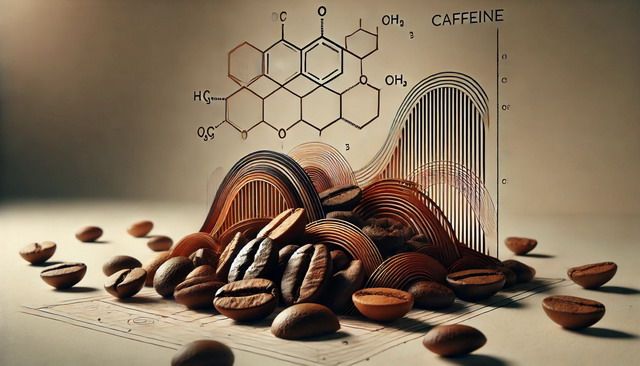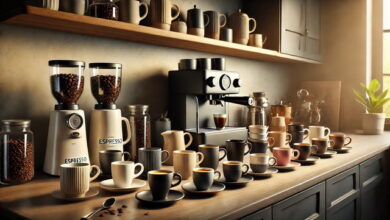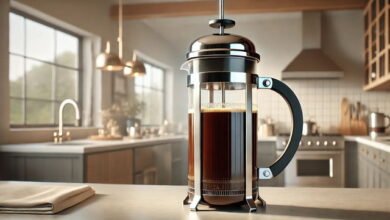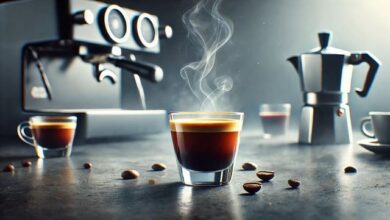Espresso is synonymous with rich, bold coffee and is beloved for its concentrated flavor and powerful caffeine punch. Whether you enjoy a single shot to kick-start your morning or snack on chocolate-covered espresso beans for a midday boost, espresso’s caffeine content is a key factor that many coffee lovers consider. But how much caffeine is actually in those tiny beans that pack such a big punch?
When it comes to caffeine, espresso beans are often the subject of curiosity and confusion. Is there a difference between espresso beans and regular coffee beans? How much caffeine do you really consume when eating espresso beans versus drinking a shot of espresso? Does the roasting process change the caffeine levels, and how do decaffeinated options compare?
In this comprehensive guide, we’ll explore everything you need to know about caffeine in espresso beans. From understanding the basics of espresso beans and their caffeine content to exploring factors that influence caffeine levels, this article will equip you with the knowledge to make informed decisions about your coffee consumption. Whether you’re a seasoned espresso drinker or just curious about how many espresso beans are safe to eat, we’ve got you covered!
1. What Are Espresso Beans and How Are They Different from Regular Coffee Beans?
Espresso beans are a widely misunderstood concept in the world of coffee, often leading to confusion for both casual coffee drinkers and enthusiasts alike. While espresso is a popular way of brewing coffee, it is frequently assumed that espresso beans are fundamentally different from regular coffee beans. The reality is, espresso beans aren’t a separate variety of bean but rather a specific roast designed to optimize the flavors and characteristics of coffee when brewed as espresso. Let’s dive into what sets espresso beans apart and how they differ from regular coffee beans.
Understanding Espresso Beans
First, it’s important to clarify that espresso beans are typically just coffee beans that have been roasted in a way that enhances their suitability for espresso brewing. Any coffee bean—whether it’s a robusta or arabica variety—can technically be used to brew espresso. However, the specific roasting process makes a significant difference in how these beans perform in an espresso machine and how they taste when brewed.
Espresso beans are generally roasted longer and darker than beans intended for drip coffee or other brewing methods. This longer roasting process brings out deeper, richer flavors while also muting some of the brighter, acidic notes that you might find in lighter roasts. The darker roast helps create that bold, intense flavor that is a hallmark of espresso. It also aids in the extraction process when hot water is forced through finely ground beans at high pressure, resulting in the concentrated shot of coffee we know as espresso.
On the other hand, beans for regular drip coffee or pour-over methods are often roasted lighter to medium levels, preserving more of their natural acidity and nuanced flavors. Light-roasted beans retain a wider range of flavor notes, including fruity and floral undertones, that might be lost in a darker roast. The brewing method is also slower and more gentle, allowing more subtle flavors to emerge.
What Sets Espresso Beans Apart from Regular Coffee Beans?
Espresso beans are chosen with the intent of creating a strong, balanced flavor profile that holds up under the intensity of the espresso brewing process. Let’s explore the key factors that differentiate espresso beans from regular coffee beans:
- Roast Level:
Espresso beans are typically roasted to a medium-dark or dark level. The darker roast level helps to caramelize the sugars in the beans, bringing out more chocolatey, nutty, and sometimes smoky flavors. In contrast, beans meant for regular coffee are often roasted to a lighter level to preserve their acidity and more complex, delicate flavors. The darker roast also reduces the bean’s overall acidity, which results in the smoother, less tangy taste of espresso compared to lighter-roasted coffees. - Grind Size:
The grind size for espresso is much finer than that for regular coffee. Espresso machines force hot water through finely ground coffee at high pressure, so the grind must be very fine to allow for proper extraction. Regular coffee, particularly drip or pour-over, requires a coarser grind to ensure the water can flow through the grounds at a slower rate, extracting flavors gradually. If you use a regular coffee bean ground too finely, it could lead to over-extraction, resulting in a bitter or overly strong taste. - Blending:
Espresso blends are often a mix of different coffee beans chosen to balance acidity, body, and flavor when brewed as espresso. These blends are designed to be versatile enough to produce a consistent, strong flavor even in the small volume of an espresso shot. In contrast, beans for drip coffee might be single-origin, chosen for their unique flavor characteristics rather than balance. - Brewing Method:
Brewing espresso requires a specific method that uses high pressure (around 9 bars or more) to push hot water through finely ground coffee quickly—usually in under 30 seconds. This method extracts a concentrated amount of coffee and leaves behind a layer of crema on top, a creamy, golden-brown foam. Regular coffee, on the other hand, uses gravity to let water slowly filter through coarser grounds, creating a larger volume of coffee that is less concentrated.
Can You Use Regular Coffee Beans for Espresso?
The short answer is yes, but with some caveats. While you can use regular coffee beans to make espresso, the results may not be as satisfying as if you used beans specifically roasted and ground for espresso. Regular beans, especially those that are lightly roasted, might taste overly acidic, sour, or weak when brewed as espresso because they don’t have the deep, bold flavors that come from a darker roast. Moreover, if the beans are not ground finely enough, the espresso machine may not be able to extract the coffee properly, resulting in a weak or watery shot.
On the flip side, you can also use espresso beans to make regular coffee, but be prepared for a richer, more intense flavor. The darker roast of espresso beans may overpower some brewing methods, leading to a coffee that tastes more robust or even a bit bitter. However, if you enjoy strong coffee, this could be a welcome result.
2. How Much Caffeine Is in One Espresso Bean?
Now that we’ve clarified the distinction between espresso and regular coffee beans, let’s address the question of caffeine content. The caffeine level in an espresso bean depends on various factors, including the type of coffee bean used (arabica or robusta), the roast level, and even the method of brewing.
On average, a single espresso bean contains about 6 milligrams of caffeine. While this may seem like a small amount, the concentration increases when you brew espresso. A typical shot of espresso uses around 60-70 beans, which translates to approximately 63 milligrams of caffeine per shot, though this can vary depending on the type of bean and brewing method.
Factors Influencing Caffeine Content
- Bean Variety:
Robusta beans contain about twice the caffeine of arabica beans. Espresso blends that incorporate robusta beans may have a higher caffeine content. - Roast Level:
While it’s commonly believed that darker roasts have more caffeine, the opposite is true. Lightly roasted beans retain more caffeine, though the difference is relatively small. - Serving Size:
Espresso is concentrated, so while a single bean may not have much caffeine, the total caffeine in a shot is potent due to the number of beans used.
3. Caffeine in Espresso Beans vs Brewed Espresso: What’s the Difference?
When it comes to caffeine content, one of the most common misconceptions is that consuming espresso beans directly offers the same caffeine hit as drinking a shot of espresso. While both forms come from the same source—the coffee bean—the amount of caffeine they deliver can vary significantly. The difference comes down to how the caffeine is extracted during brewing versus eating espresso beans directly.
How Much Caffeine Is in Brewed Espresso?
A typical single shot of espresso, which is around 1 ounce (30 milliliters), contains approximately 63 milligrams of caffeine. However, this number can vary depending on factors such as the type of coffee bean (arabica or robusta), the brewing method, and the volume of coffee used. For instance, a double shot of espresso naturally contains twice as much caffeine, averaging around 125 milligrams.
The espresso brewing method extracts a concentrated amount of caffeine in a short period of time. Water is forced through finely ground espresso beans at high pressure, pulling out caffeine along with other oils, flavors, and compounds. This efficient extraction method delivers a potent shot of caffeine in a small volume, which is why espresso is often favored for its boldness and quick energy boost.
How Much Caffeine Is in a Single Espresso Bean?
In contrast, consuming espresso beans directly will not deliver the same caffeine jolt as a brewed espresso shot—at least not in the same quantity. A single espresso bean contains roughly 6 milligrams of caffeine, meaning you would need to eat around 10 beans to match the caffeine content of one shot of espresso. However, keep in mind that the body absorbs caffeine more slowly when eating whole beans compared to when drinking brewed coffee. The slower absorption may lead to a more gradual and sustained energy boost, whereas a shot of espresso offers an immediate caffeine hit.
Caffeine Absorption: Eating vs. Drinking Espresso
The way your body processes caffeine from eating espresso beans differs from the way it processes caffeine from brewed espresso. When you eat espresso beans, caffeine is absorbed more gradually through your digestive system, potentially leading to a slower and more prolonged release of energy. On the other hand, brewed espresso delivers caffeine directly into your bloodstream through the liquid form, resulting in a faster and more noticeable jolt of energy. This difference in caffeine absorption is why eating espresso beans might not feel as intense as drinking a shot of espresso, even if the overall caffeine content is similar.
4. How Does the Roasting Process Affect Caffeine Content in Espresso Beans?
The roasting process plays a critical role in the caffeine content and flavor profile of espresso beans. Contrary to popular belief, the roast level doesn’t significantly change the amount of caffeine in a bean. However, it does affect the flavor, aroma, and intensity of the coffee. Let’s break down how different roasting levels impact the caffeine content and overall characteristics of espresso beans.
Does a Dark Roast Mean More Caffeine?
Many people assume that darker roasts contain more caffeine because of their strong, bold flavors. However, the opposite is actually true. Lighter roasts tend to have slightly more caffeine than darker roasts, but the difference is minimal. Caffeine content is relatively stable and only begins to break down at extremely high temperatures, much higher than those used in typical coffee roasting.
How Roasting Affects the Bean’s Structure
The primary change that occurs during roasting is the loss of moisture in the beans. As beans roast longer and darker, they lose more moisture, which makes them lighter and less dense. This means that when you measure coffee by volume (such as a scoop of coffee beans), lighter roasts may actually have more caffeine since the beans are denser and you end up using more beans in the scoop. When you measure coffee by weight, however, darker roasts will contain less caffeine because the beans have expanded and lost some of their mass during roasting.
Roast Levels and Flavor Profiles
While the caffeine content doesn’t vary drastically between roast levels, the flavor does. Espresso beans are usually roasted to a medium-dark or dark level to create a rich, bold flavor profile that stands up well to the intensity of espresso brewing. Dark roasting reduces the bean’s natural acidity and brings out deeper, more robust flavors like chocolate, caramel, and nuts, which are characteristic of a well-pulled shot of espresso.
Lighter roasts, on the other hand, tend to preserve the bean’s more delicate, complex flavors, including floral, fruity, or citrusy notes. While these are often desirable in other brewing methods like pour-over or drip coffee, they can result in an overly acidic or sour taste when brewed as espresso, which is why most espresso beans are roasted darker.
5. Are Espresso Beans Stronger in Caffeine Than Regular Coffee Beans?
A frequent question among coffee drinkers is whether espresso beans are inherently stronger than regular coffee beans in terms of caffeine content. The answer lies not in the type of bean itself but in how the coffee is prepared and consumed.
Caffeine Content in Espresso Beans vs. Regular Coffee Beans
As mentioned earlier, espresso beans are not a separate variety of coffee beans—they are just roasted differently. So, in terms of raw caffeine content, there is no inherent difference between espresso beans and regular coffee beans. Both espresso and regular coffee beans can be either arabica or robusta, the two main types of coffee beans used worldwide. Robusta beans naturally contain more caffeine than arabica beans, regardless of whether they are roasted for espresso or drip coffee.
The difference in caffeine content comes down to the brewing method and serving size. Espresso is a highly concentrated form of coffee, meaning that while a shot of espresso contains less liquid than a cup of drip coffee, it packs a much higher concentration of caffeine. In contrast, a regular cup of drip coffee uses more water and a coarser grind, which extracts caffeine over a longer period of time, resulting in a larger serving size with less concentration of caffeine per ounce.
Serving Size Matters
A shot of espresso typically contains 60-70 milligrams of caffeine in just 1 ounce of liquid, while an 8-ounce cup of drip coffee can contain anywhere from 80 to 120 milligrams of caffeine. Although drip coffee has more caffeine overall due to the larger serving size, espresso offers a more intense caffeine hit per ounce.
The Perception of Strength
The perception that espresso beans are stronger than regular coffee beans often comes from the intense flavor of espresso. The darker roast, combined with the brewing method, produces a bold, concentrated taste that feels “stronger” to the palate, but this doesn’t necessarily mean there’s more caffeine in each individual bean. It’s more about how the beans are used, ground, and brewed.
In summary, espresso beans are not inherently stronger in caffeine than regular coffee beans. The strength of the coffee depends more on the brewing method, serving size, and the type of beans used (arabica or robusta) rather than the beans being labeled as “espresso” or “regular.” Whether you prefer a bold shot of espresso or a milder cup of drip coffee, the key to understanding caffeine content lies in the preparation, not the label.
6. How Many Espresso Beans Can You Eat Without Overdosing on Caffeine?
Espresso beans, often coated in chocolate or eaten on their own, offer a delicious and energy-boosting snack. However, there’s a limit to how many you can safely consume before your caffeine intake reaches unhealthy levels. Caffeine overdose is rare, but it can occur if you consume too much caffeine in a short period of time. So how many espresso beans are safe to eat, and when should you stop?
Understanding Caffeine Tolerance
Before determining how many espresso beans are too many, it’s essential to understand that caffeine tolerance varies from person to person. Factors such as body weight, age, metabolism, and overall caffeine sensitivity play a role in how your body reacts to caffeine. On average, adults can safely consume up to 400 milligrams of caffeine per day, which equates to roughly 6 cups of brewed coffee or about 5-6 shots of espresso.
As previously discussed, a single espresso bean contains about 6 milligrams of caffeine. If you do the math, eating around 67 espresso beans would bring you to the 400-milligram daily limit. However, this is not a recommended amount to consume in one sitting, as the combination of caffeine and the natural oils found in coffee beans could upset your stomach, cause jitters, and lead to other unpleasant side effects.
Symptoms of Caffeine Overconsumption
Exceeding your caffeine tolerance can lead to several unwanted symptoms, including:
- Jitters or nervousness
- Increased heart rate (tachycardia)
- Difficulty sleeping (insomnia)
- Upset stomach or nausea
- Headaches or dizziness
In extreme cases of caffeine overdose, symptoms like vomiting, heart palpitations, or confusion can occur. It’s essential to monitor your intake of espresso beans, especially if you’re consuming other caffeinated products throughout the day, such as energy drinks, sodas, or tea.
How Many Espresso Beans Are Safe to Eat?
Given that a typical serving of chocolate-covered espresso beans contains around 12-15 beans, this is generally a safe amount to eat without going overboard on caffeine. Eating around 20-30 beans should provide a noticeable energy boost, but keep in mind your total caffeine intake for the day. If you’ve already had a few cups of coffee or energy drinks, you’ll want to adjust how many beans you eat to avoid overconsumption.
For those particularly sensitive to caffeine, it’s advisable to start with a smaller amount—perhaps 5-10 beans—and see how your body reacts. Always listen to your body, as caffeine affects everyone differently.
7. Factors That Affect Caffeine Levels in Espresso Beans
When it comes to understanding how much caffeine is in espresso beans, several factors influence the final caffeine content. These include the type of coffee bean, the growing region, and even the specific roast level. By understanding these variables, coffee drinkers can make more informed decisions about the beans they purchase and consume.
1. Coffee Bean Variety (Arabica vs. Robusta)
The two most common types of coffee beans used to make espresso are Arabica and Robusta, and they differ significantly in caffeine content:
- Arabica beans are prized for their smooth, rich flavor and lower acidity. They tend to have about 1.2% caffeine by weight, making them the go-to choice for premium coffee blends.
- Robusta beans, on the other hand, are known for their stronger, more bitter taste and contain about 2.2% caffeine by weight—nearly double that of Arabica beans. This higher caffeine content makes them a popular choice for espresso blends designed to deliver a bold, intense kick of energy.
Espresso blends often contain a mix of Arabica and Robusta beans to balance flavor and caffeine content. If you prefer a milder flavor with less caffeine, go for an Arabica-heavy blend. If you need a stronger caffeine boost, blends with more Robusta may be more suited to your needs.
2. Growing Region and Climate
Where your espresso beans are grown plays a crucial role in their caffeine content. Beans grown at higher altitudes, particularly Arabica beans, tend to have lower caffeine levels but more complex flavor profiles. On the other hand, Robusta beans, often grown at lower altitudes in places like Vietnam, Africa, and Indonesia, thrive in harsher conditions and develop higher caffeine content as a natural defense against pests.
Coffee beans grown in more temperate regions, such as those from Ethiopia, Colombia, or Guatemala, often exhibit a more balanced flavor and slightly lower caffeine levels compared to Robusta beans from Southeast Asia or West Africa. The growing conditions, including soil composition, rainfall, and temperature, all influence the bean’s chemical makeup, including its caffeine concentration.
3. Roasting Process
As mentioned earlier, the roasting process also affects the caffeine levels in espresso beans. Although roasting beans to a darker level does not drastically reduce caffeine content, it does affect the bean’s density and overall mass, which can influence how much caffeine you consume per serving.
Because dark-roasted espresso beans are less dense than lighter-roasted beans, you might need to use more beans to achieve the same weight when brewing. This could result in slightly more caffeine in your cup of espresso, even though each individual bean may contain slightly less caffeine than a lightly roasted one.
8. Do Espresso Beans Have More Caffeine Than Drip Coffee?
This is a question that often comes up among coffee enthusiasts: Does espresso have more caffeine than drip coffee? The answer is both yes and no, depending on how you compare the two. Let’s break it down.
Caffeine Concentration per Ounce
Espresso is more concentrated than drip coffee. A single 1-ounce shot of espresso contains approximately 63 milligrams of caffeine. In comparison, an 8-ounce cup of drip coffee contains around 80-120 milligrams of caffeine, depending on the brew strength and bean variety used. So, while drip coffee has more caffeine overall in a larger serving size, espresso has significantly more caffeine per ounce.
Total Caffeine Intake
If you’re comparing a single shot of espresso to a full cup of drip coffee, the latter will generally provide more total caffeine. However, if you were to consume multiple shots of espresso—say, a double shot or triple shot—you would quickly surpass the caffeine content of a single cup of drip coffee.
For example:
- A single shot of espresso (1 ounce) contains 63 milligrams of caffeine.
- A double shot of espresso (2 ounces) contains around 125 milligrams of caffeine.
- An 8-ounce cup of drip coffee contains between 80 and 120 milligrams of caffeine.
So, if you’re looking for a quick, concentrated caffeine boost, espresso is your best bet. On the other hand, if you prefer to sip your coffee over a longer period of time, drip coffee will give you a more gradual, steady intake of caffeine.
Factors That Influence Caffeine Levels in Drip Coffee and Espresso
It’s important to note that several variables influence caffeine levels in both drip coffee and espresso. These include:
- Bean variety: As discussed earlier, Robusta beans have significantly more caffeine than Arabica beans. A cup of drip coffee made with Robusta beans could contain more caffeine than an espresso shot made with Arabica beans.
- Brewing time: Drip coffee brews for a much longer time compared to espresso, allowing more caffeine to be extracted from the beans. This is one reason why a cup of drip coffee often contains more caffeine in total than a shot of espresso.
- Serving size: A standard serving of drip coffee is much larger than an espresso shot, which accounts for the higher total caffeine content.
In conclusion, while espresso delivers more caffeine per ounce, drip coffee generally provides a higher overall caffeine intake due to its larger serving size. Ultimately, the choice between espresso and drip coffee comes down to personal preference and how you prefer to consume your caffeine.
9. Decaffeinated Espresso Beans: Do They Exist?
Yes, decaffeinated espresso beans do exist! For coffee lovers who enjoy the rich, bold flavor of espresso but are sensitive to caffeine or want to reduce their intake, decaffeinated espresso beans provide a great alternative. But how are these beans made, and do they still contain any caffeine?
How Are Espresso Beans Decaffeinated?
The process of decaffeination typically involves removing most of the caffeine from the coffee beans while preserving as much of the flavor as possible. There are several methods used to decaffeinate coffee beans, including:
- The Swiss Water Process:
This chemical-free method uses water to extract caffeine from the beans. It works by soaking the green coffee beans (before they’re roasted) in hot water, which draws out both caffeine and flavor compounds. The water is then passed through a carbon filter to remove the caffeine. The beans are then re-soaked in the now-flavorful water, allowing them to reabsorb the flavor while leaving most of the caffeine behind. This process removes around 99.9% of the caffeine from the beans. - The CO2 Process:
This method uses liquid carbon dioxide to selectively remove caffeine from coffee beans. Green beans are soaked in water and placed in a stainless steel tank, where liquid CO2 is introduced at high pressure. The CO2 bonds with the caffeine molecules, pulling them out of the beans while leaving most of the flavor compounds intact. The CO2 is then removed, and the caffeine is extracted from it, leaving decaffeinated beans behind. - Solvent-Based Decaffeination:
In this method, coffee beans are treated with solvents like methylene chloride or ethyl acetate to remove caffeine. After soaking the beans, the caffeine is extracted by the solvent, and the beans are then washed and dried to remove any solvent residue. While this method is effective at removing caffeine, some coffee enthusiasts avoid it due to concerns about chemical residues, though it is considered safe by regulatory agencies.
Do Decaf Espresso Beans Still Contain Caffeine?
It’s important to note that decaffeinated espresso beans are not entirely caffeine-free. Even after decaffeination, trace amounts of caffeine remain in the beans. On average, a shot of decaf espresso contains about 2-5 milligrams of caffeine, compared to the 63 milligrams in a regular shot. While this is a small amount, it’s worth considering if you’re highly sensitive to caffeine or aiming for zero caffeine intake.
Decaf espresso beans are a popular choice for those who want to enjoy espresso’s bold flavor without the stimulating effects of caffeine, especially in the evening or for those who are sensitive to caffeine’s impact on sleep.
Conclusion: The Importance of Knowing Caffeine Levels in Espresso Beans
Understanding how much caffeine is in espresso beans is essential for anyone who enjoys coffee, whether you’re drinking brewed espresso or snacking on chocolate-covered beans. From the variety of the bean to the roasting process, the method of brewing, and even the way you consume the coffee (whether eating or drinking it), several factors can influence how much caffeine you’re taking in.
Key Takeaways:
- Espresso beans are not a different type of bean but are typically roasted darker to suit the espresso brewing method, which extracts caffeine efficiently in small volumes.
- A single espresso bean contains around 6 milligrams of caffeine, and it takes about 10 beans to match the caffeine content of one shot of brewed espresso.
- The roasting process doesn’t significantly affect caffeine content, but the bean’s density and overall flavor profile do change with different roast levels.
- Factors like the variety of coffee (Arabica vs. Robusta) and growing region play a significant role in determining the caffeine content of espresso beans.
- Caffeine absorption varies depending on whether you eat espresso beans or drink brewed espresso. Drinking espresso delivers a faster caffeine hit, while eating the beans leads to a slower release.
- Decaffeinated espresso beans are a great option for those looking to reduce their caffeine intake while still enjoying the rich taste of espresso.
Balancing Flavor and Caffeine Intake
Whether you’re a coffee novice or a seasoned enthusiast, understanding the caffeine content in espresso beans helps you make informed choices about your daily coffee consumption. If you’re after a quick, concentrated burst of energy, a shot of espresso will provide that in a small serving. But if you prefer a slower, more gradual release of caffeine, snacking on espresso beans might be your ideal option.
Ultimately, the amount of caffeine you consume depends on your personal tolerance and preferences. By paying attention to the factors that influence caffeine levels in espresso beans—such as bean variety, roasting method, and brewing technique—you can enjoy your coffee experience to the fullest while keeping your caffeine intake in check.








